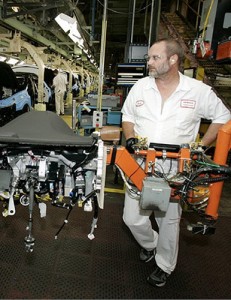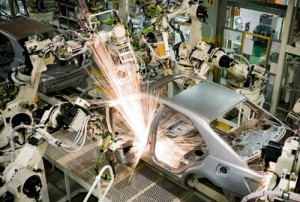Manufacturing is the end result of many other decisions, from the first sketch of a new product to the initial marketing study by those tasked with selling it. Then come hours of engineering, and finally, the development of the factory processes required to make the concept a reality.
The blessing for anyone who understands manufacturing is that the basic way that things are made has not changed since the beginning of the industrial age.
But the techniques used inside factories have changed significantly, while the Web has sped the way consumers learn about and react to the products that come off the assembly line.
As you learn about manufacturing, remember that it is a global business. The market for vehicles in China affects decisions made in Detroit. The ability of a plant in Vietnam to make the hottest fashions has an impact on designers in New York. Mexican production flow will determine whether a supermarket shelf in Chicago’s Little Village is stocked with Coca-Cola.
That might seem complicated, but it means that the concepts you learn will be applicable wherever you find a factory.
Inventory
Essentially, this means supply. Inventory is the simplest measurement of what goes into a factory, and what comes out of it. Companies have inventories of components and materials that go into their products, and accumulate inventories of finished goods to ship to their dealers or vendors. In turn, these dealers and customers measure the goods they have on hand as inventory. Here are 10 basic terms you need in your manufacturing vocabulary:
Productivity
This is a measure of output. Think of it as the batting average for a factory. Productivity reflects how much time it takes to produce a product, often divided by how many workers are involved. In modern manufacturing, high productivity generally means producing the most goods possible with the lowest number of workers possible. But manufacturers also measure productivity in terms of the output per worker. Companies also look at the productivity of their machinery, which reflects a number of things, such as the design of the machines, the way they are programmed and how well they are maintained.
Capacity Utilization
the percentage of time a factory is in operation. This is generally measured on a five-day week, with two eight-hour shifts of workers. This is called “straight time.” The time on top of this that the factory operates is called overtime. Minimally, a factory needs to be in operation at least 75 percent of the time, to cover the costs of inventory, maintenance, salaries and distribution. The best factories run at 100 percent of “straight-time” capacity. A capacity-utilization number above 100 percent reflects overtime.
Download our free guide to covering money on 17 beats.
Bottleneck
problems that prevent a factory from running smoothly. Bottlenecks are sometimes physical obstacles on the assembly line. But they also can be slow deliveries or shortages of parts. Bottlenecks can take place because some workers are not properly trained and require more time to complete their tasks on the assembly line. Bottlenecks also can take place when machinery breaks down and needs to be repaired. Weather can cause a bottleneck in deliveries, particularly in the winter.
Andon cord
A cord, like a clothesline, that hangs above the assembly line. One pull on the andon (pronounced ANN-don) slows the assembly line; a second pull generally stops the line. This concept was popularized by Japanese automakers, who gave their employees the authority to slow or stop the line when a problem occurs. Nowadays, the line is rarely stopped except for an emergency. Generally, a tug on the cord will summon a supervisor, who will bring in other workers if needed to solve a problem.
Just in Time (JIT)
An inventory system that keeps only the number of parts required to complete production on one shift or one day. The JIT system, also popularized in Japan, has its roots in American supermarkets. It is modeled after the “stock-from-behind” system used in dairy cases. As a customer removes one carton of milk, a new carton is pushed to the front.
Kaizen
A Japanese term that means “continuous improvement.” Kaizen (KYE-zen) is an effort to do things faster and more efficiently. On the factory floor, workers in Japanese factories are encouraged to provide feedback and suggestions, often taking time at the end of their shifts to brainstorm ideas. To “kaizen” a problem means to dissect it and come up with solutions. Kaizen also is used in a white-collar environment, to speed up product development.

The 5 S’s
A visual measurement of the efficiency of a factory. The 5 S’s are sort, straighten, sweep, standardize and sustain. The list describes the ways to keep order on the assembly-line floor. Sorting means to categorize tools and keep only those required near a workstation. Straightening is the way those tools are arranged, and returned after use. Sweep is to keep a clean work area. Standardize means to have common methods for performing work. Sustain describes the practice of performing the 5 S’s. The best factory experts say they can take a look around a factory and tell how well the 5 S’s are being applied.
Automation
Machinery that does work that used to be performed manually. In its most common usage, automation means robots. In many cases, robots have replaced labor-intensive, difficult processes, such as welding pieces of metal together, but they also have taken the place of workers whose job it was to move parts down the assembly line. In German factories, such as Mercedes-Benz’ plant near Stuttgart, you will see robots picking up material and moving it across the factory floor. Automation also has taken over many tasks in food processing, such as filling containers and stamping out cookies, and is often used in packaging the finished products.
Product Testing
The testing of products before they are manufactured, or shipped to consumers. For white goods, such as refrigerators, dishwashers and washing machines, and for large products such as automobiles, product testing is often performed at the end of the assembly line. Many cars go through a water test inside the factory to make sure they are air tight. Product testing also takes place before goods are put into production. Engines, transmissions and other components often undergo hours of product testing to measure their durability.










